Panama, 2013
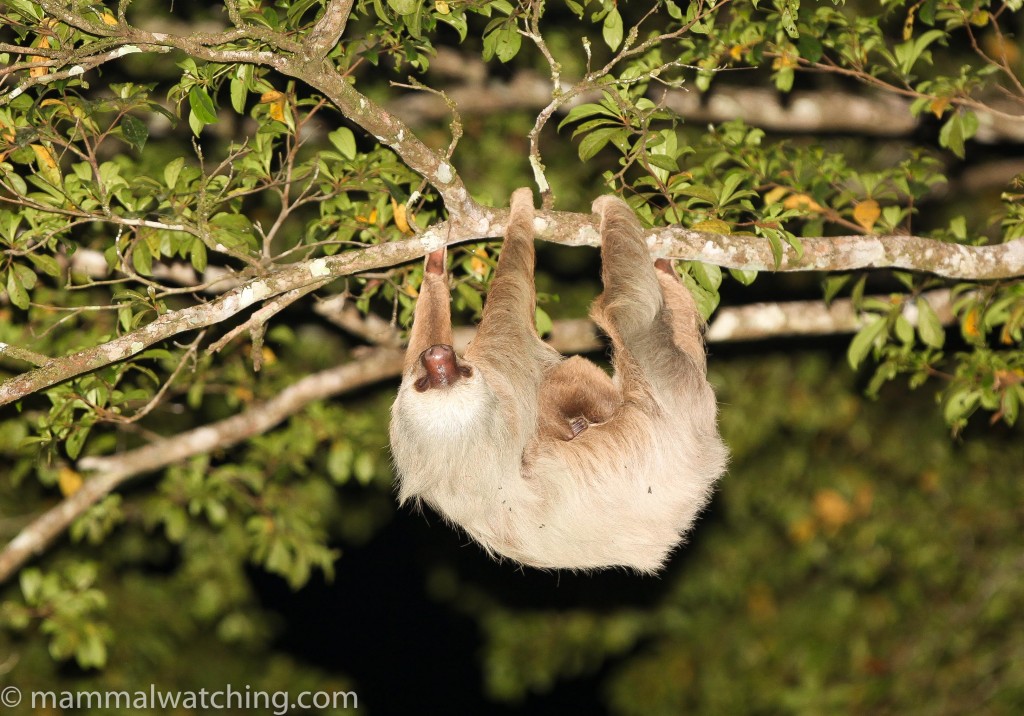
Two-toed Sloth and baby, Choloepus hoffmanni, near the Canopy Tower
Although Panama had been on my radar for a while I’d never thought all that seriously about visiting until Fiona Reid reminded me it was a great spot for some mammals that had avoided me elsewhere, including Woolly Opossums and Olingos. It is also easy to get to from New York, with direct return flights for under $450 return over the thanksgiving weekend for example. Sold.
For this first, quick, visit at the end of November 2013, I decided to spend a night at the Canopy Lodge, in Valle del Anton,two nights at the Canopy Tower, in Gamboa, and a final night on Barro Colorado Island, near Gamboa. There are many other places to visit in Panama, but I figured with just four days available, this itinerary would optimise my chances of seeing a range of mammals and be relaxed enough for my girlfriend to enjoy.
My main concern about a visit in late November was the weather. The rainy season ends in mid-December usually, but the weather was great for us. We had heavy rain only on the first day and again as I was driving back to the airport. But that was it. It didn’t affect any of the mammal watching, and an off-season visit meant that the lodges were quiet so it was an ideal time to visit.
The Canopy Lodge
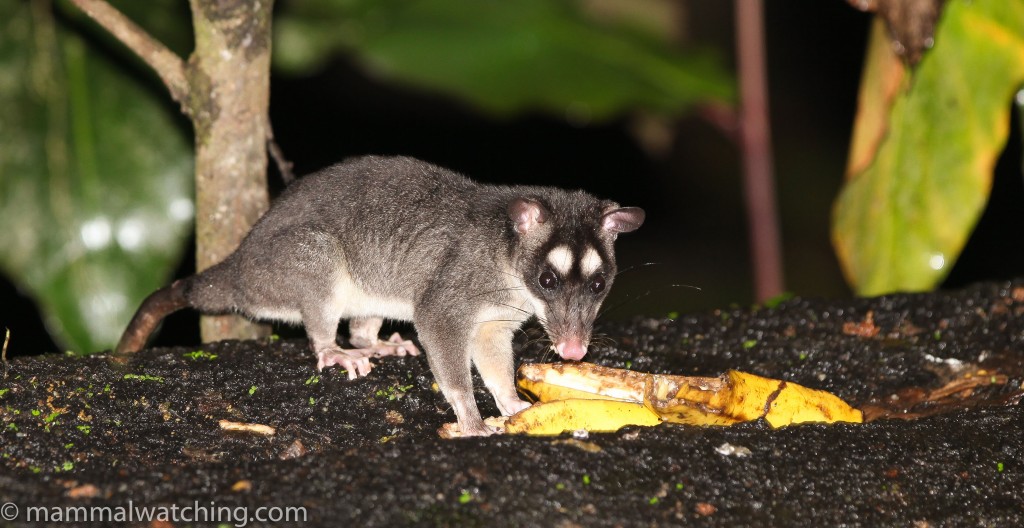
Dark Four-eyed Opossum, Philander melanurus
The Canopy Lodge is 2.5 hours’ drive from Panama City. Beware the directions on the lodge website: the kilometre markings only work if you start from the airport and zero your odometer. They do not correspond with the km posts on the road. So it took us 3.5 hours to get there.
The lodge is comfortable and in a nice setting. The only other guests were Jeff Higgott and his partner Catriona, both also interested in mammals and with lots of useful advice on Panama. The lodge guide, Eliecer, was excellent. He told me to keep an eye on the lodge’s bird tables after dark as Common Opossums often visited. I didn’t see a Common Opossum that night, but there was a Dark Four-eyed Opossum (only the second time I had seen a Four-eyed Opossum) at dusk, closely followed by my first Central-American Woolly Opossum.
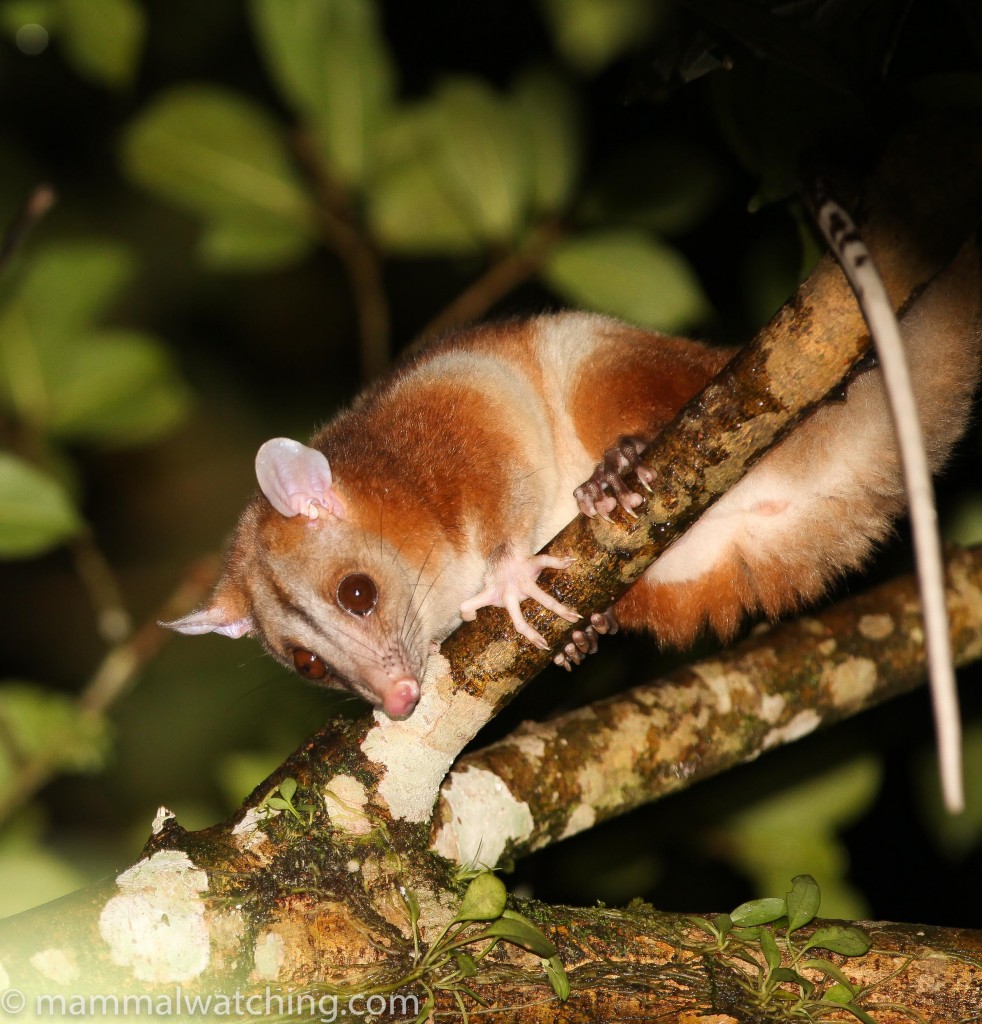
Central American Woolly Opossum, Caluromys derbianus
Bats started arriving at the hummingbird feeders not long after the Opossums had arrived, at least some of which were Orange Nectar Bats, apparently regular at the feeders and another lifer for me.
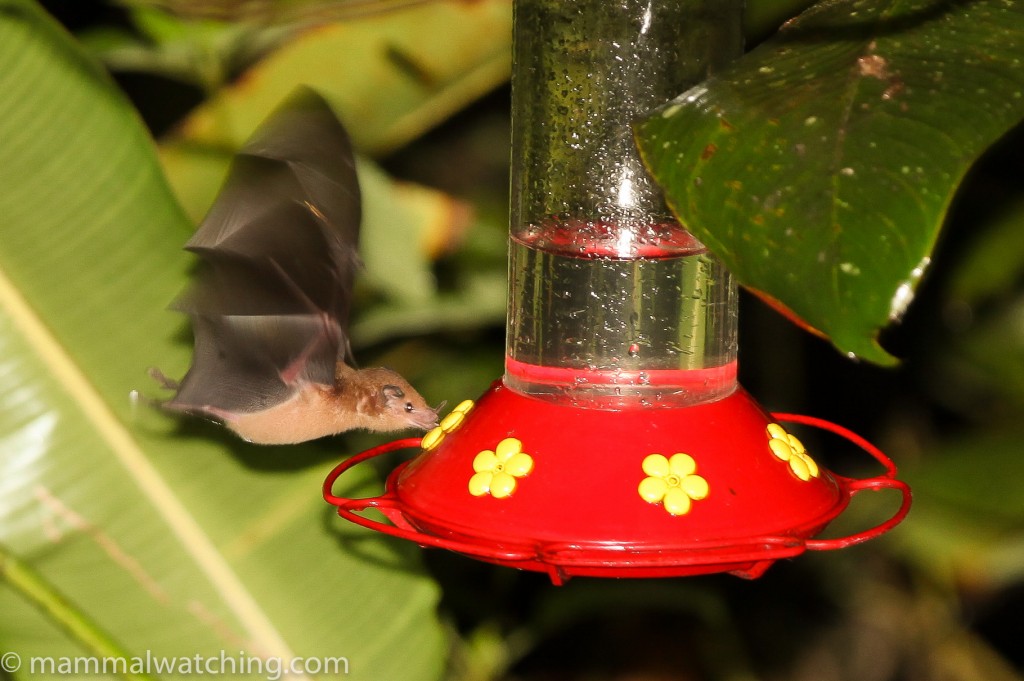
Orange Nectar-Bat, Lonchophylla robusta
After some Thanksgiving Turkey, we took a night walk with Eliecer along the road. We didn’t see any mammals on the walk up the hill, other than another Dark Four-eyed Opossum. But the way back, perhaps because the wind had dropped, was much better. We had prolonged views of a Kinkajou though it was high up and hard to photograph. After seeing several Olingos later in the trip it seems that Kinkajous tend to move around a lot less in the spotlight. They also use their prehensile tail to good effect, which is a helpful diagnostic when identifying this species as Olingos don’t have a prehensile tail.
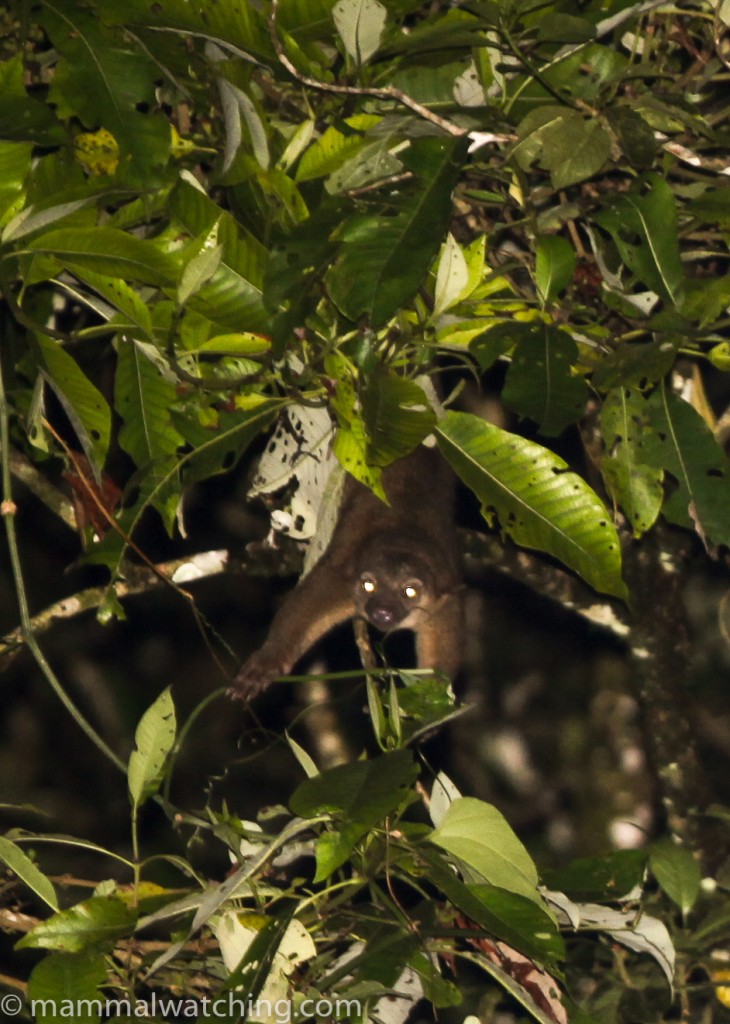
Kinkajou, Potos flavus
There was yet another Dark Four-eyed Opossum on the road, a brief look at a Hoffman’s Two-toed Sloth and my first Tomes’ Spiny Rat alongside the creek near the waterfall.
The walk ended up lasting three hours, and so Eliecer gets points for both his spotting skills and his enthusiasm.
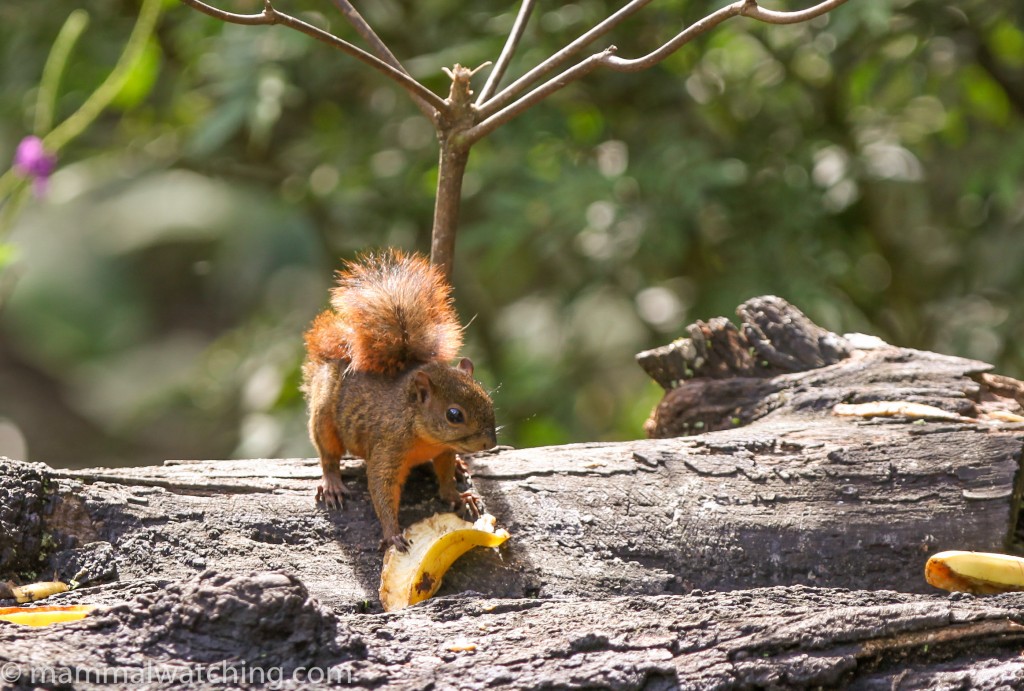
Red-tailed Squirrel, Sciurus granatensis
The next morning at 7 a.m., when fresh bananas appeared at the bird tables, so did a couple of Central American Agoutis and several Red-tailed Squirrels.
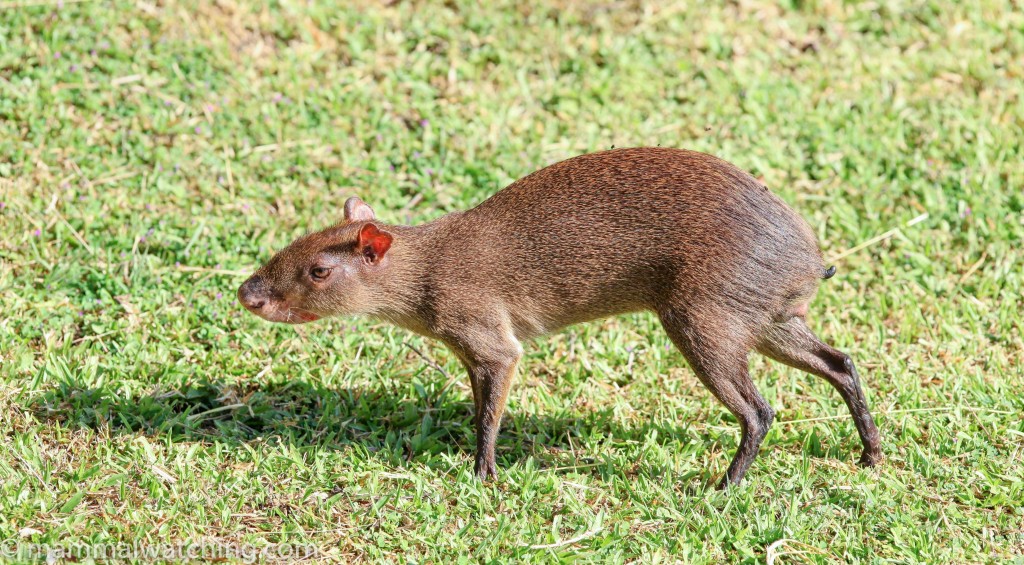
Central American Agouti, Dasyprocta punctata
There are other mammals, of course, which I didn’t see. Geoffroy’s Tamarins and Olingos are around, though both are probably easier to see at the Canopy Tower. Elicier had seena a Tayra a couple of days earlier, and a month ago they’d had a Water Opossum in the creek that runs through the lodge.
The Canopy Tower, Gamboa
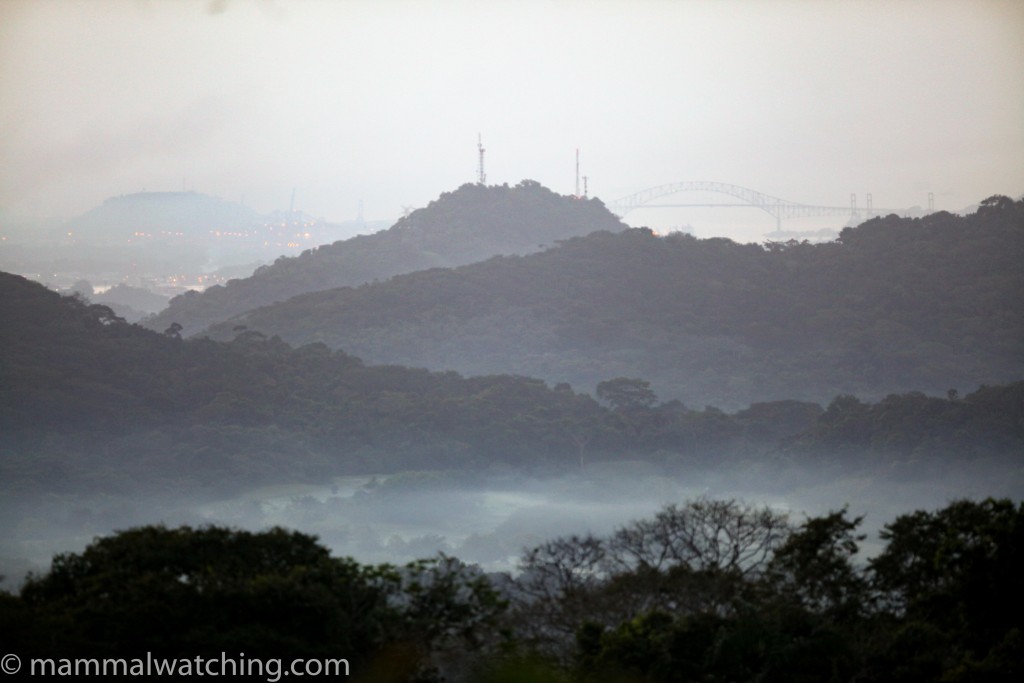
View of Panama City from the Canopy Tower
The Canopy Tower is two hours’ drive from the Canopy Lodge (or only 45 minutes from Panana City airport). The tower – which is also the lodge – is a former US airforce radar station. The building is made of metal and it feels a little like sleeping in a submarine. But the setting, and the mammal watching, is excellent (see the list of potential species): the tower is only a few miles from the famous Pipeline Road and presumably has most of the same species.
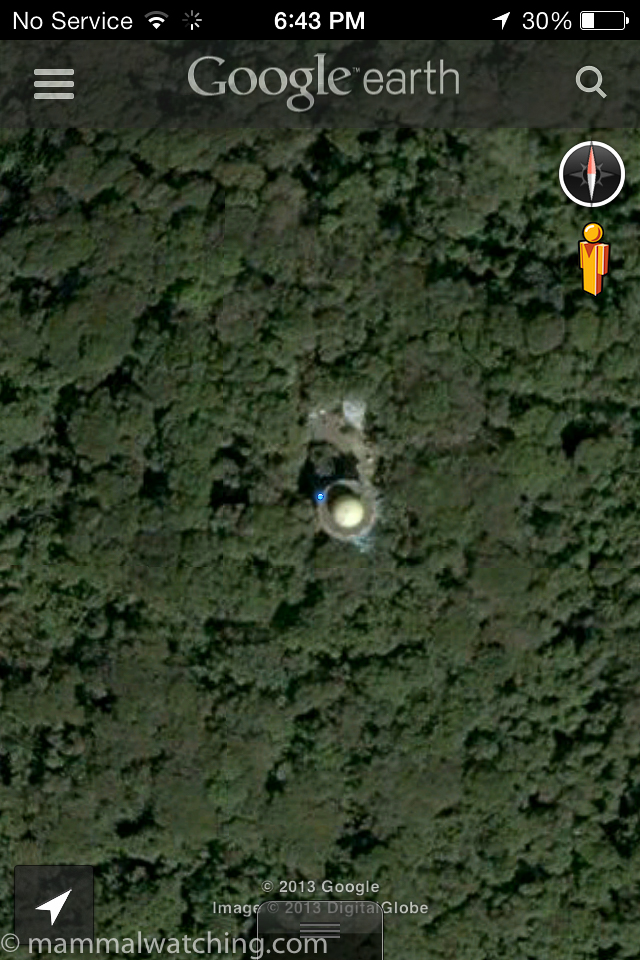
The Canopy Tower
The entrance road to the tower can be good. Tayra are sometimes reported along here as are Rothschild’s Porcupines, and one had been seen crossing the road a couple of days earlier. We saw some White-nosed Coatis in the afternoon, and there were bats living in most of the culverts I checked, but the only species I could get a good look at were a Merriam’s Long-tongued Bat (Glossophoga mutica) in the same pipe as a group of Common Big-eared Bats (Mironycteris microtis).
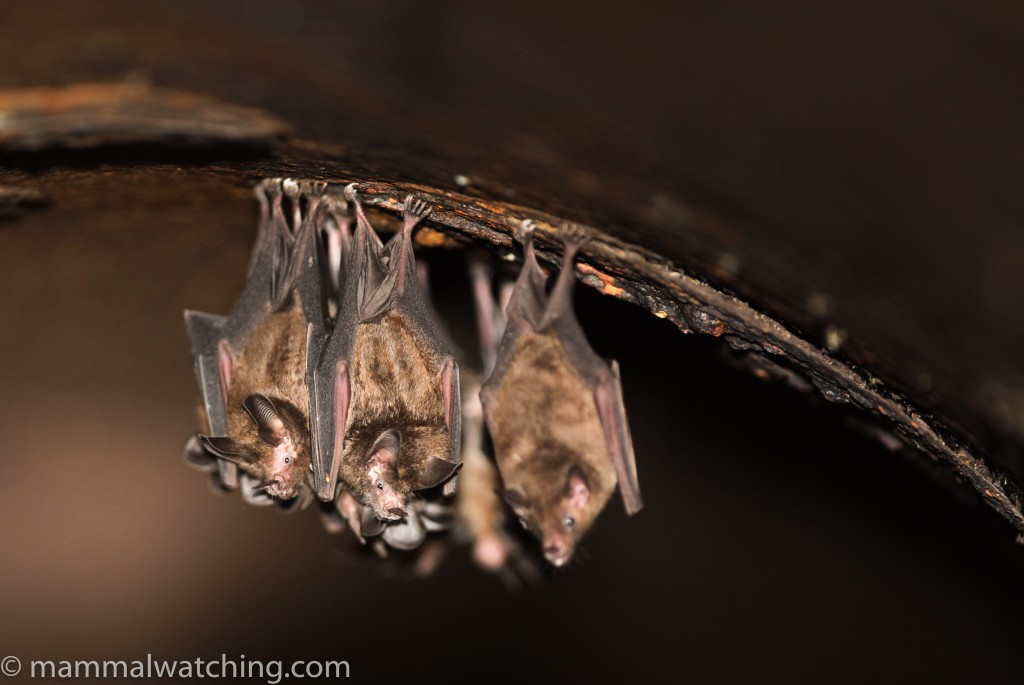
Common Big-eared Bats, Mironycteris microtis (left) and a Merriam’s Long-tongued Bat, Glossophoga mutica (right)
If there aren’t monkeys feeding outside the tower, which are often spotted from the bedrooms, you can see them along the road. There were Panamanian White-faced Capuchins early in the morning near the lodge, and Mantled Howlers were calling often.
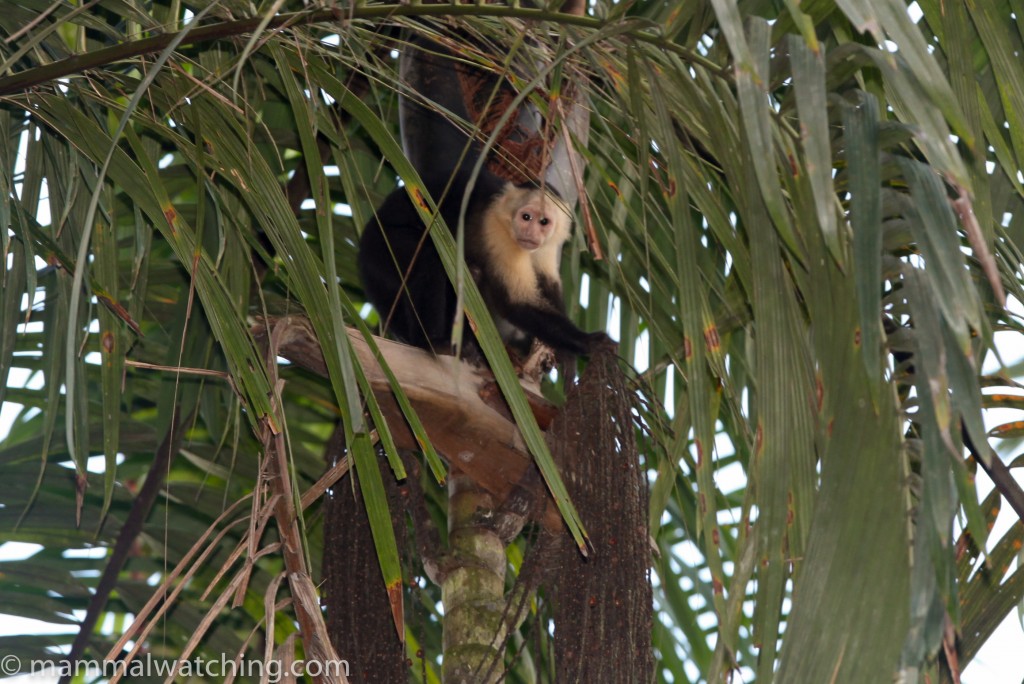
Panamanian White-faced Capuchin, Cebus imitator
A key species here for me were the Geoffroy’s Tamarins and they were easy to hear along the road after breakfast, but distant and hard to photograph: their call is much louder than other tamarins I’ve encountered.
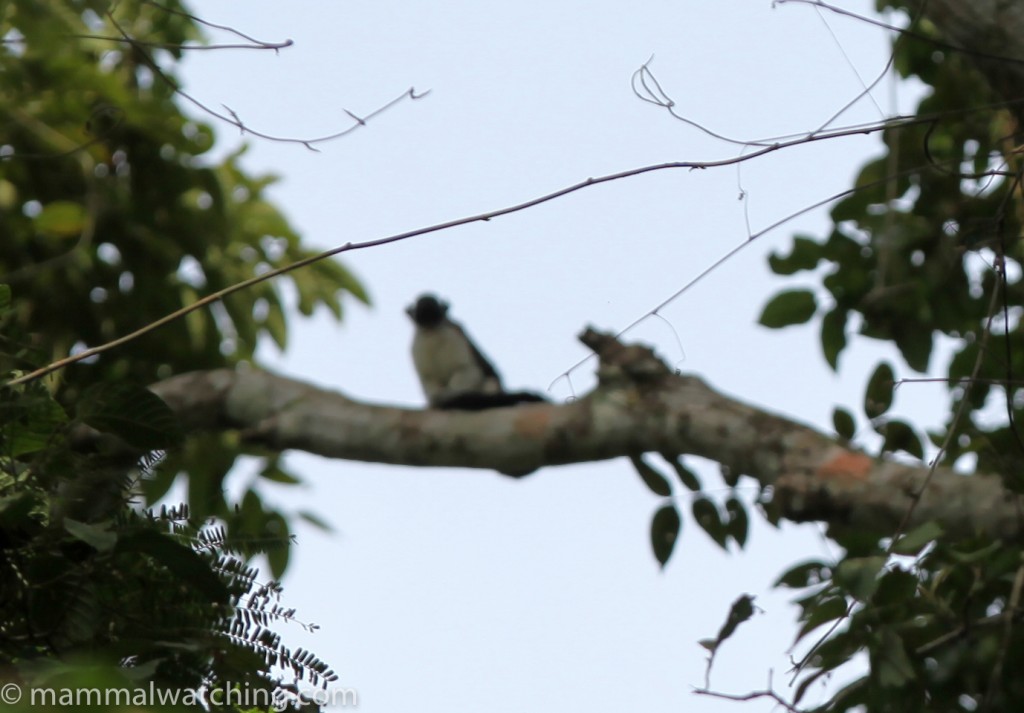
Record shot of a Geoffroy’s Tamarin, Saguinus geoffroyi
The mammal watching is even better at night. The Tower website claims that Spectral Bats can be seen feeding around the tower. I was sceptical about this. But sure enough, right on dusk, and as predicted by Jeff Higgott and Alex (the lodge guide), a couple of massive bats buzzed around the top of the tower, circling in and out of the canopy for 20 minutes. They were the size of crows and extremely hard to photograph though I managed to capture the terrible image below. I’m confident that they were, indeed, Vampyrum spectrum. First, they were quite enormous, far larger than a Greater Fishing Bat for example. Second, the flight pattern, and colour matches. I don’t know what they were feeding on: they do apparently take large insects from time to time, though normally they eat mammals, birds and reptiles. I wonder if they were hunting bats? A colony of molossids live in the Canopy Tower roof I think which might explain why we only saw the Spectral Bats on dusk. And third, one bat crashed into the “golf ball” on the top of the tower with a thud. Again somewhat consistent with Spectral Bats because they often don’t use echolocation to hunt.
This was a great species to see, though it would have been fabulous to have seen one in the hand. My theory that there is a place to see every species gets further validation!
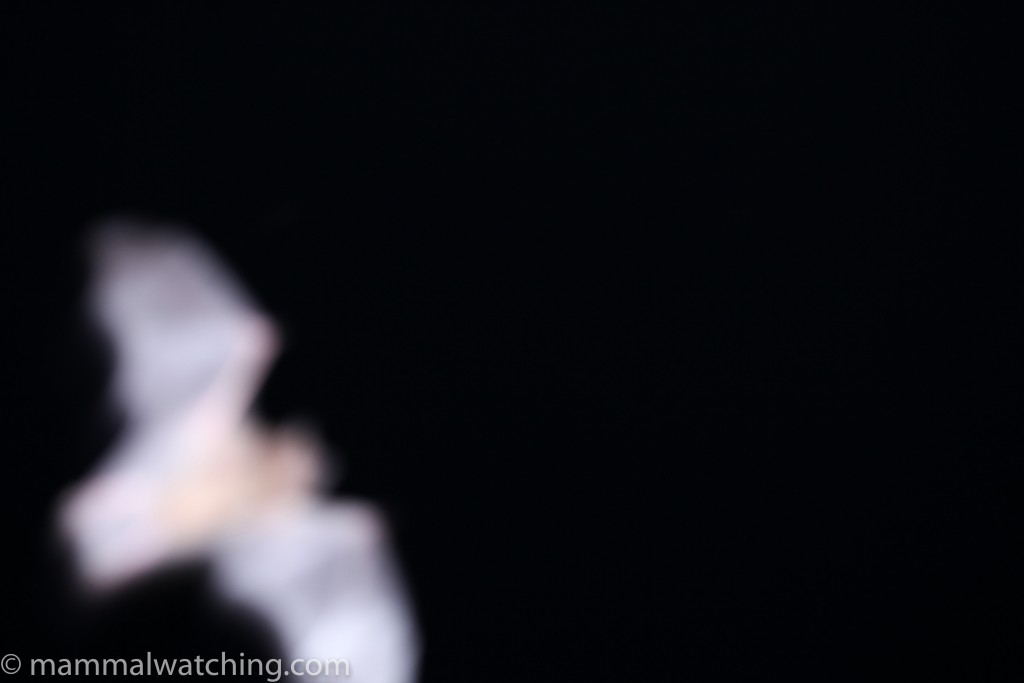
Spectral Bat, Vampyrum spectrum: bad photo, good bat!
During dinner smaller bats flitted through the dining room and I grabbed one that had crashed to the floor: a Pallas’s Bat, not the Lesser Dog-like Bat that the guides claimed these bats were.
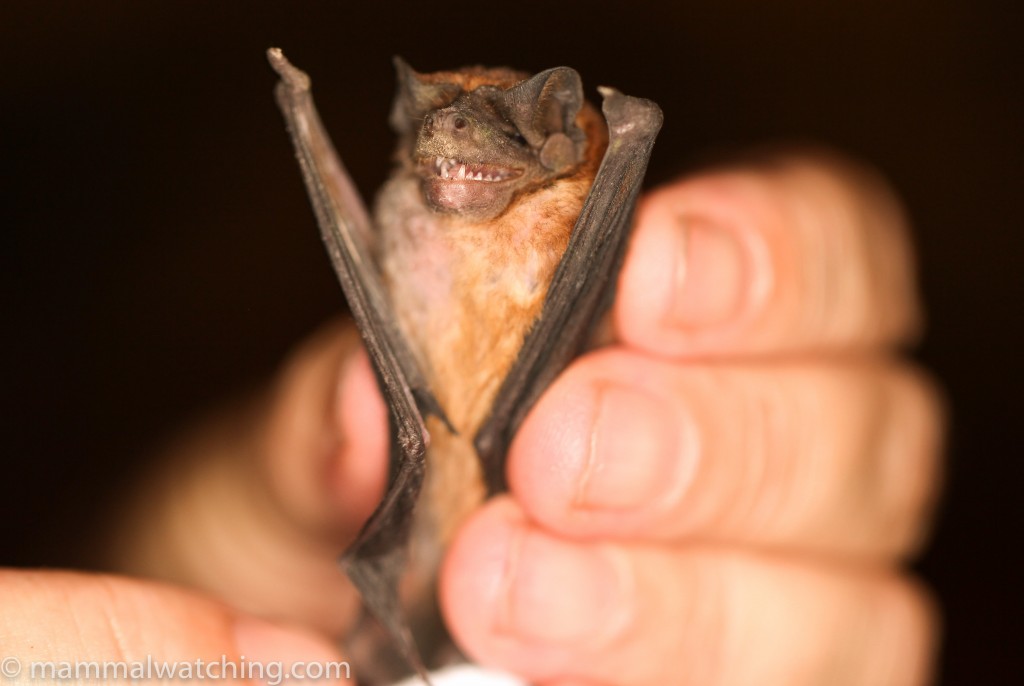
Pallas’s Bat, Molossus molossus
Officially the tower need four passengers before they will run a night drive. Although there would be nothing to stop you from driving or walking the road at night, the guides are excellent at finding stuff and it is likely you will see more with them and from the back of the truck. There were six other guests, all keen to join for a night tour, and so after dinner we spent three hours driving the entrance road from the lodge to the main road (Semaphore Hill) and then along the main road to the Summit Ponds. Both the forest and our guide Alex were excellent. We saw a couple of Olingos on the entrance road (my key target for the trip and much more elusive in the spotlight than the Kinkajou from the night before), several Two-toed Sloths, a Central American Agouti and a Central American Woolly Opossum. It seems that the Olingos around the Pipeline road are now treated as Bassaricyon medius orinomus (see this paper).
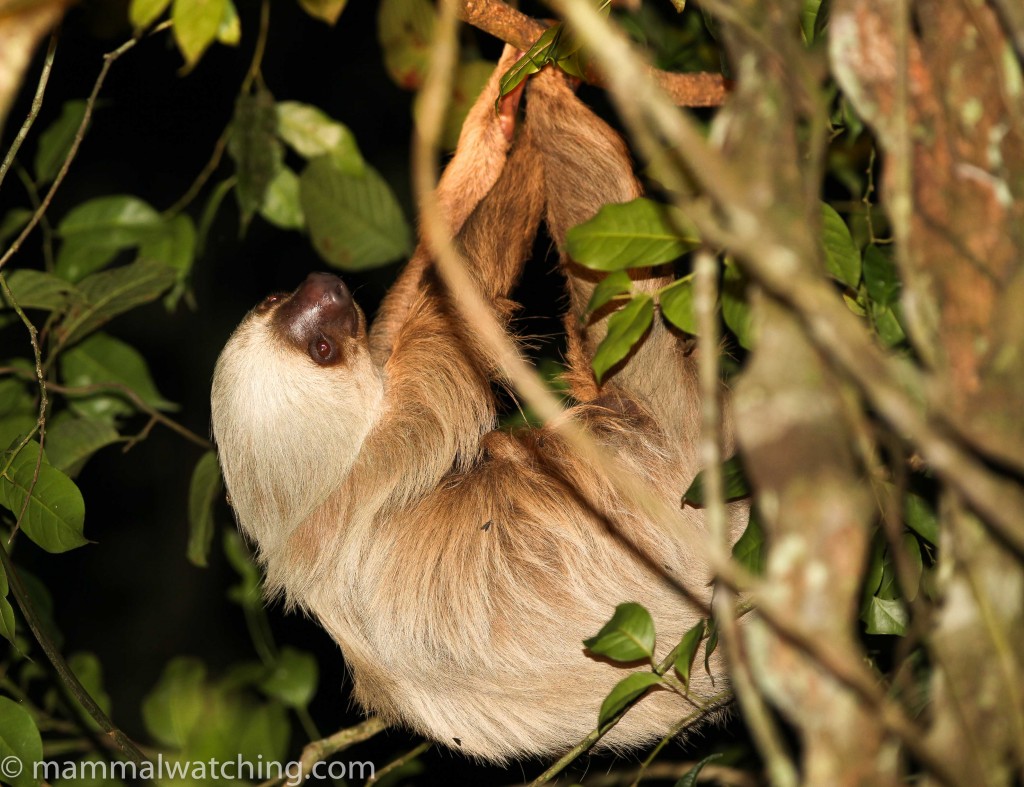
Hoffman’s Two-toed Sloth, Choloepus hoffmanni
Along the side road to the Summit Ponds we saw a Paca, which I think is quite an unusual sighting here, and my first Common Opossum. I was also hoping to see Western Night Monkeys. They are around, and seen quite often especially when Cecropia trees near the lodge are in fruit. But they hadn’t been seen for a few weeks. Moreover, the only known roost tree (along the Pipeline road) had also fallen over.
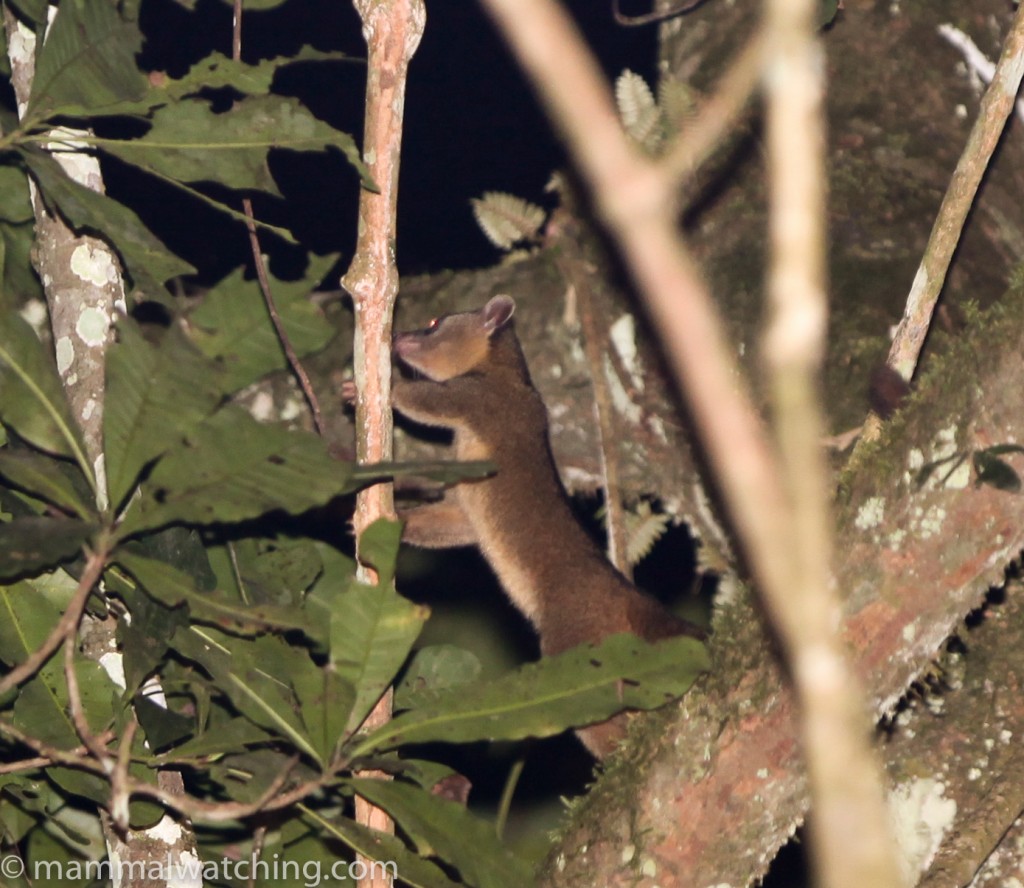
Western Lowland Olingo, Bassaricyon medius
Another – albeit shorter – night drive the next evening produced another Olingo, more Two-toed Sloths and a Nine-banded Armadillo, as well as a small reddish tree rat/mouse that Alex spotted above us but which I didn’t see.
During the middle of the day we visited the rainforest discovery centre near the start of the Pipeline Road, where there’s another canopy tower and some trails. The only mammals I saw there were an Agouti and Collared Pecccaries on the road in, plus a cluster of Seba’s Short-tailed Bats under the deck that is the discovery centre.
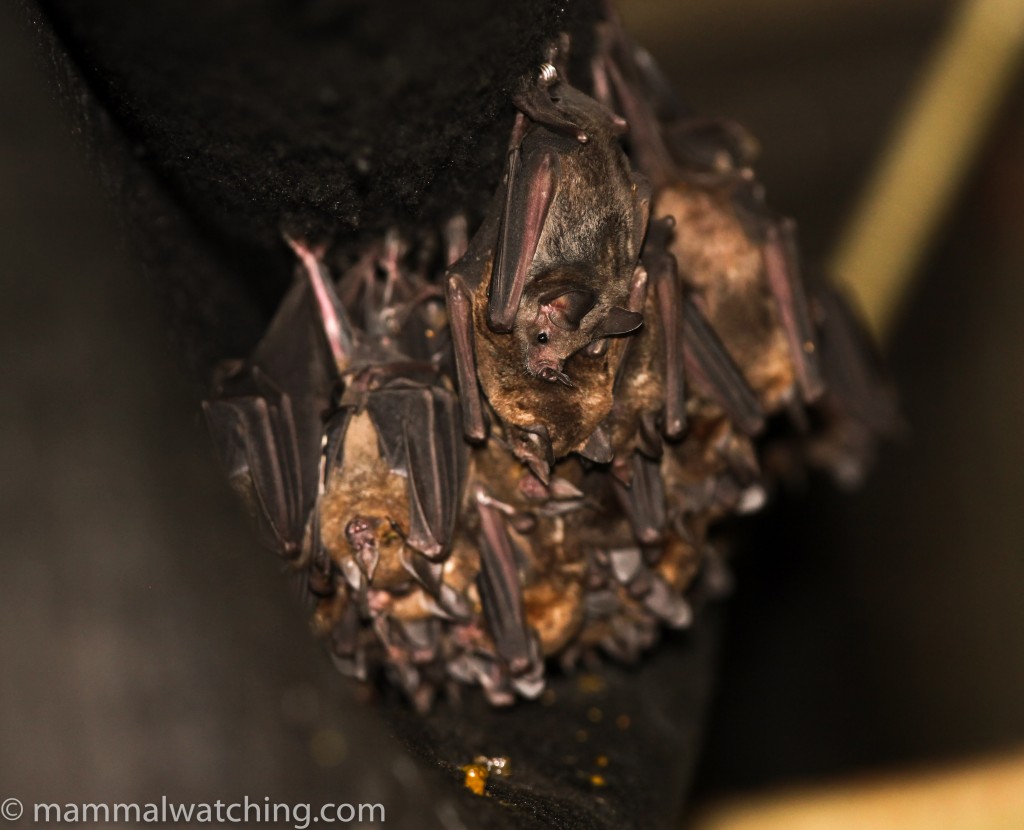
Seba’s Short-tailed Bats, Carollia perspicillata
With more time I would have spent a day on the Pipeline Road, not least because it seems a good spot for Tayras. The road begins about 15 minutes drive from the Canopy Tower. There’s a locked gate at the start but nothing to stop you from walking along it.
A week earlier the guides from the Tower had spotted a Rufous Tree Rat in a hollow tree. I visited twice at about midday and didn’t see it, but on my third visit – at 3 p.m. as I was leaving for the airport – it was there. A great beast!
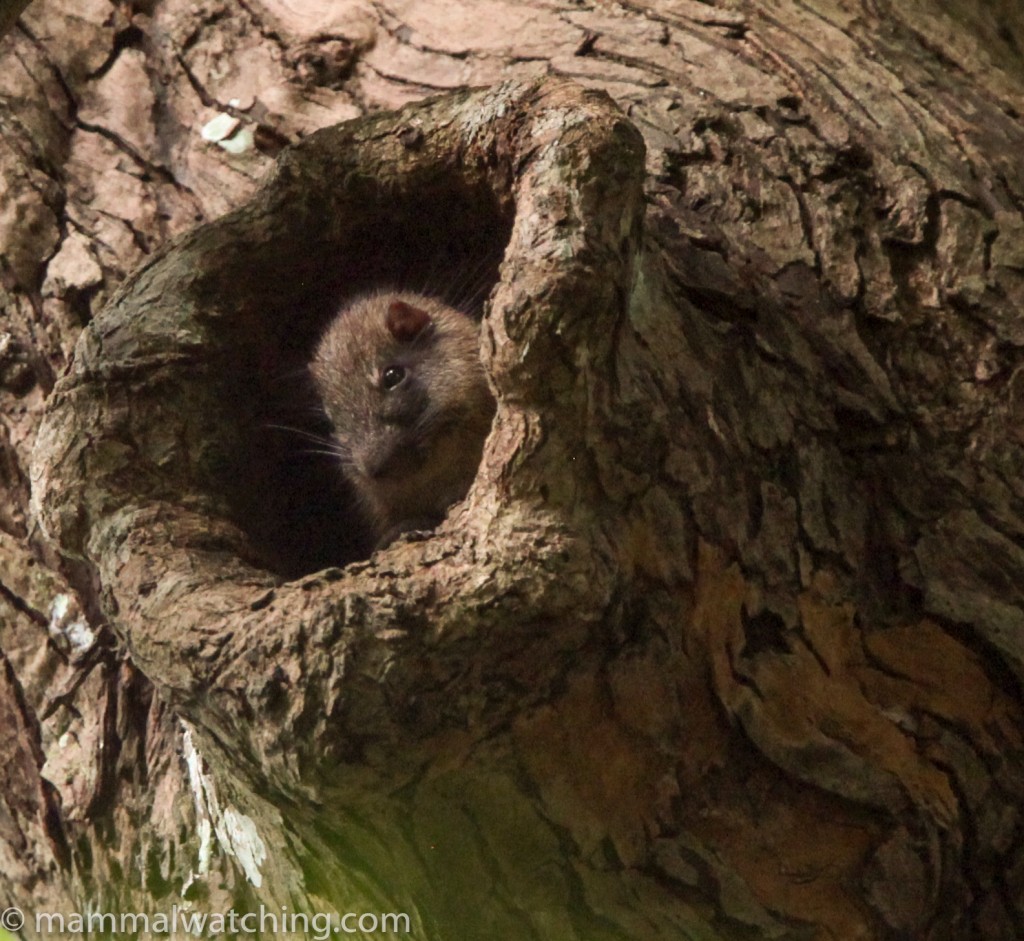
Rufous Tree Rat, Diplomys labilis
The roost tree is easy to find. Follow the road from Gamboa to the Rainforest Discovery Centre/Pipeline Road (Olio Ducto). The tree is at a fork in the road (left goes to the the discovery centre, right the pipeline road). The tree is on the right hand side (when coming from Gamboa) almost exactly at the fork and about 10 metres back into the forest. The hollow – where a branch used to sit – is about 20 feet in the air on the left hand side of the tree.
Another new species for me in the area were Lesser Capybaras. Though they are seen at the Summit Ponds occasionally, Cheryl Antonucci told me that the Gamboa Rainforest Resort was a good place to see these. And, from a mid-afternoon seat at the bar, we could see them grazing on the lakeshore lawn below the swimming pool. The place is apparently crawling with them in the evening.
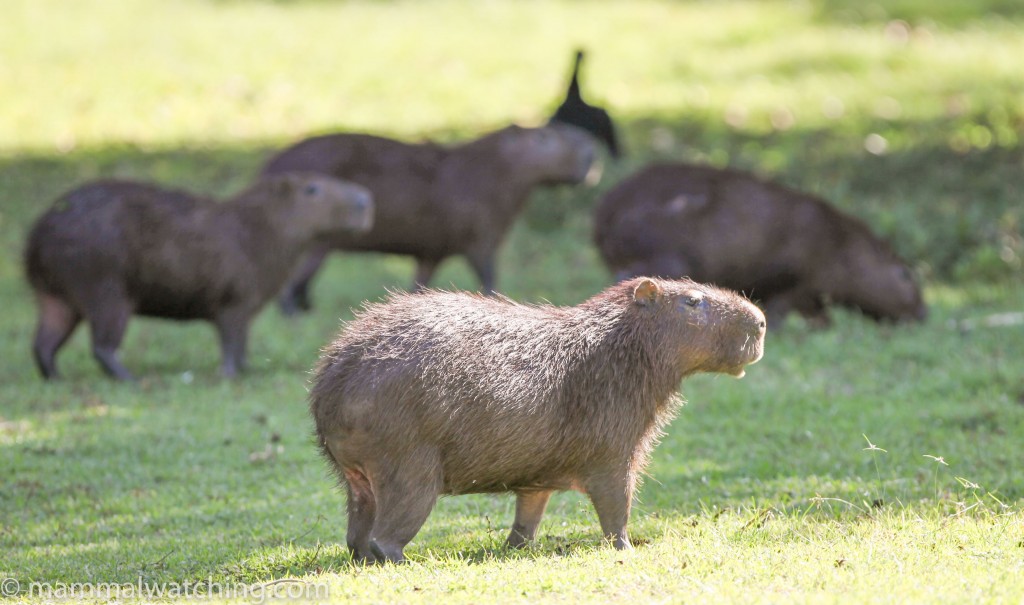
Lesser Capybaras, Hydrochoerus isthmius
Species I missed here included Western Night Monkey, Tayra and Rothschild’s Porcupines (though the latter especially is not commonly seen). I was told that Common Tent-making Bats are common around the zoo at the summit and people regularly see Neotropical River Otters when they take a boat tour of the Chagres river, lake and Monkey Island from Gamboa. The boat trip sounds fun though I didn’t find anyone who recommended visiting Monkey Island, which essentially is a zoo.
Barro Colorado Island
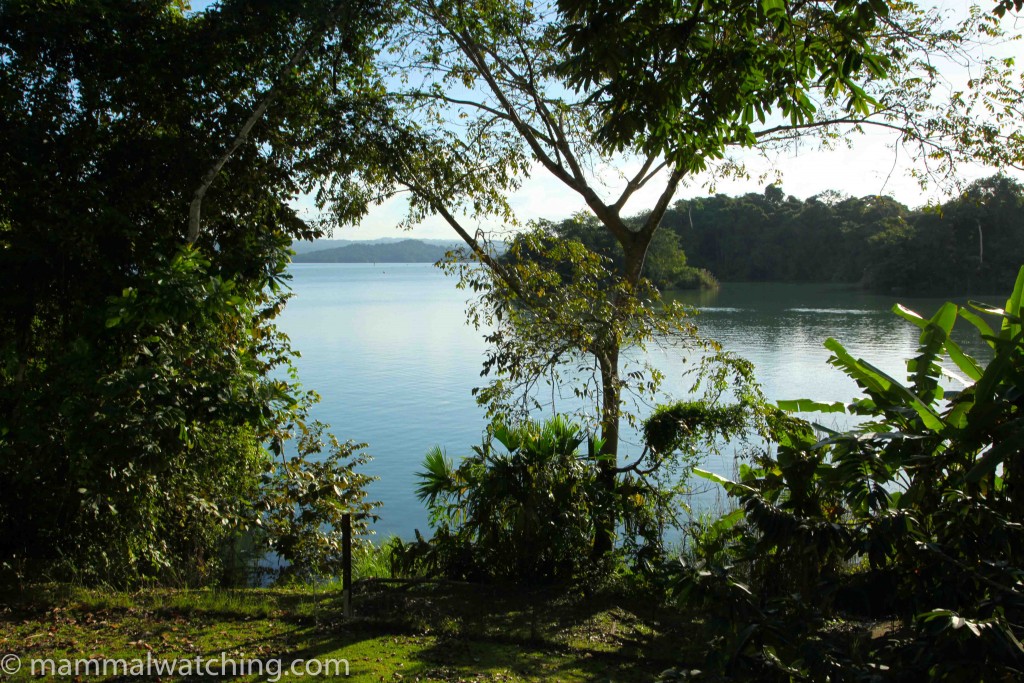
Barro Colorado Island (BCI) is managed by the Smithsonian Tropical Research Institute and the mammal list is here. Day tours are possible: the boat dock at Gamboa, from where water taxis make the 30 minute crossing to the island, is only 15 minutes from the Canopy Tower.
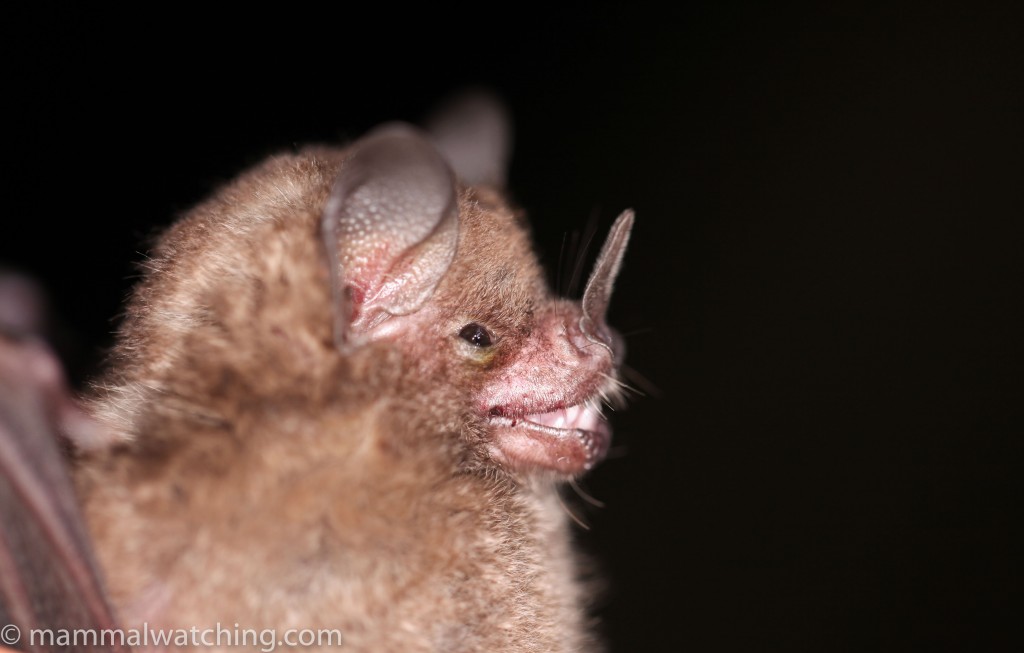
Seba’s Short-tailed Bat, Carollia perspicillata
Fiona Reid was good enough to introduce me to Rachel Page who works with bats on the island. And though Rachel wasn’t going to be there, she was – like so many bat bioligists – super helpful, and arranged for me to be able to stay the night (something that is only possible with an invitation) and go out netting with Thomas Hiller from the University of Ulm in Germany.
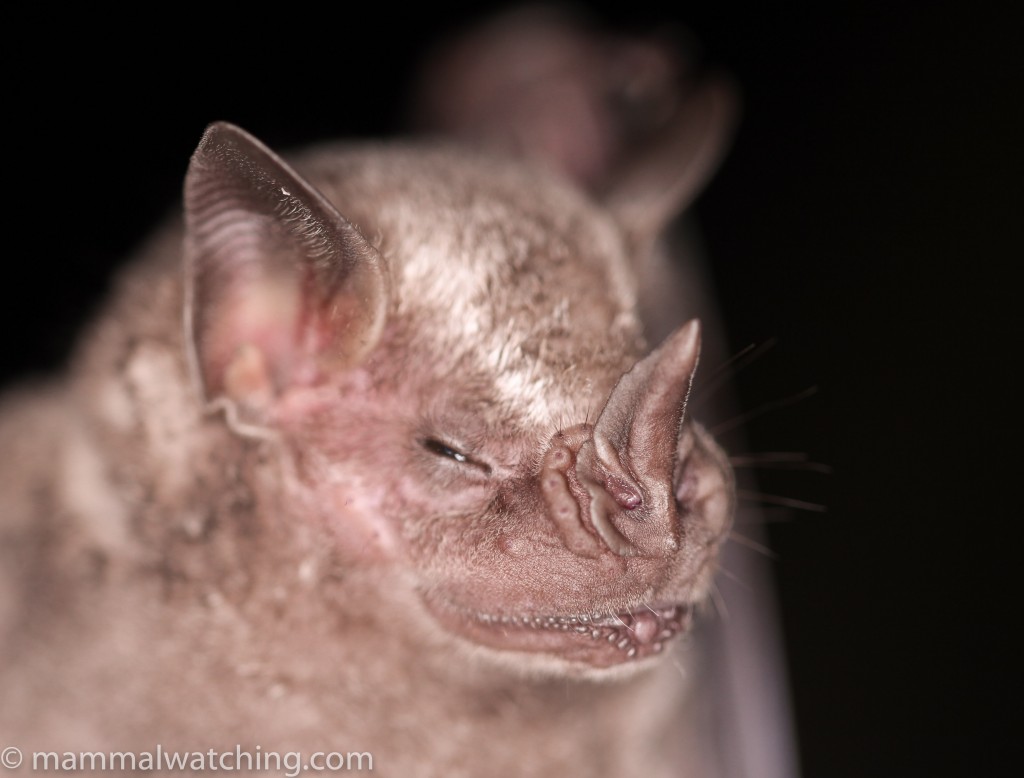
Jamaican Fruit-eating Bats, Artibeus jamaicensis, the dominant species on the islandd.
Thomas is a great guy. He’s been on the island for eight months and he picked a top spot for an evening’s netting where he hoped to catch some nice species. I wasn’t disappointed. In five hours we caught nine species.
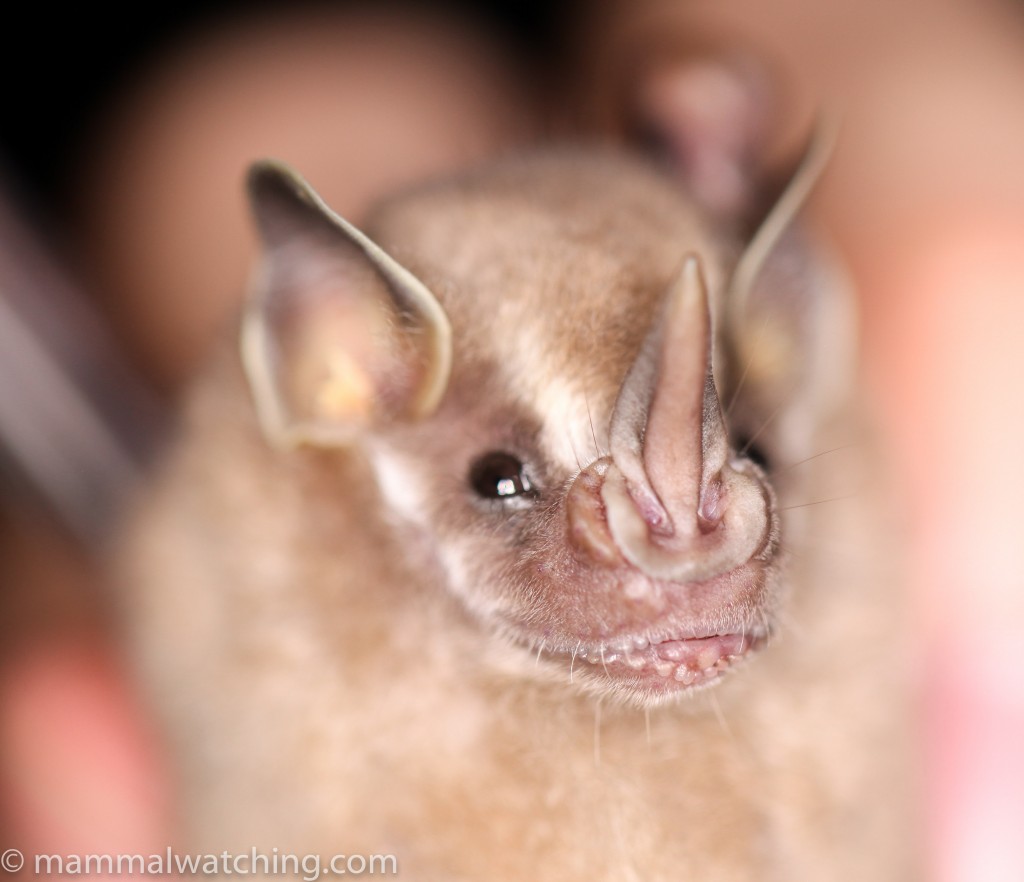
Thomas’s Fruit-eating Bat, Artibeus watsoni
They included a Thomas’s Fruit-eating Bat, which I’d never seen in the hand before.
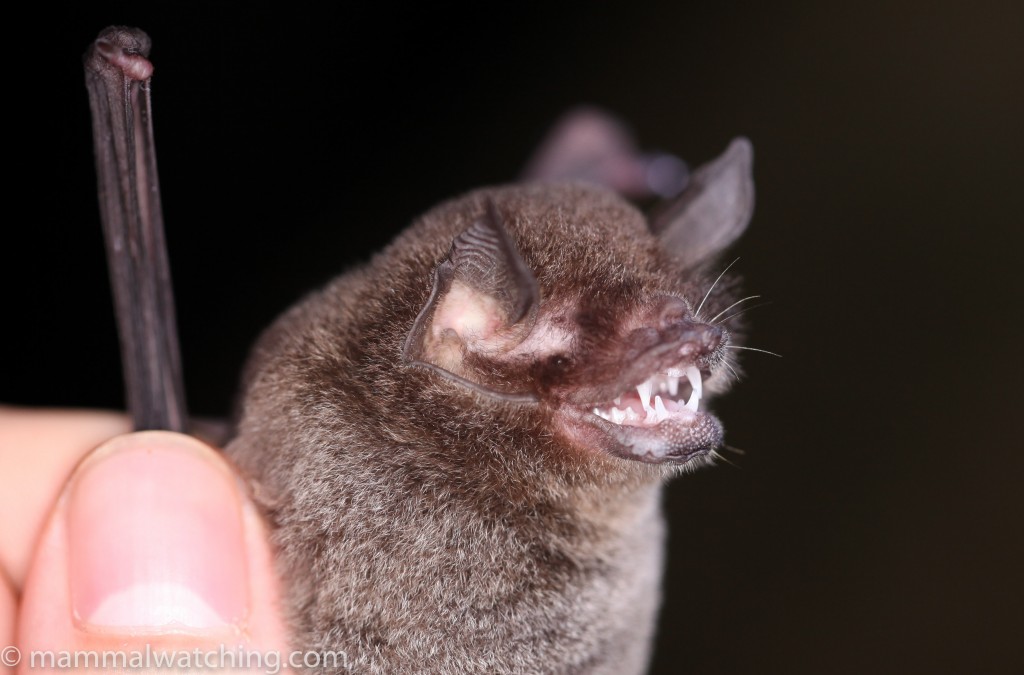
Mesomamerican Moustached Bat, Pteronotus mesoamericanus
Along with some Mesomamerican Moustached Bats (now split from Pteronotus parnellii) and Common Tent-Making Bats.
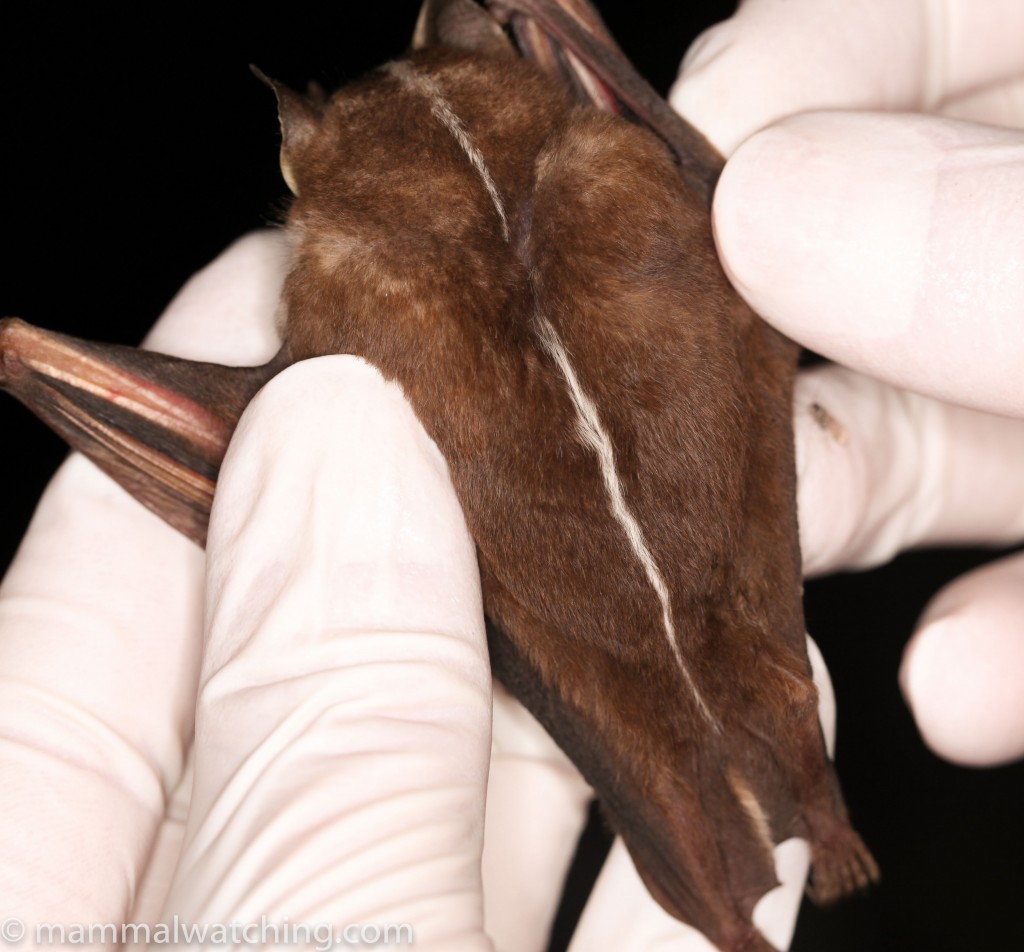
Common Tent-making Bat, Uroderma bilobatum
A Northern Stripe-headed Round-eared Bat was a lifer for me.
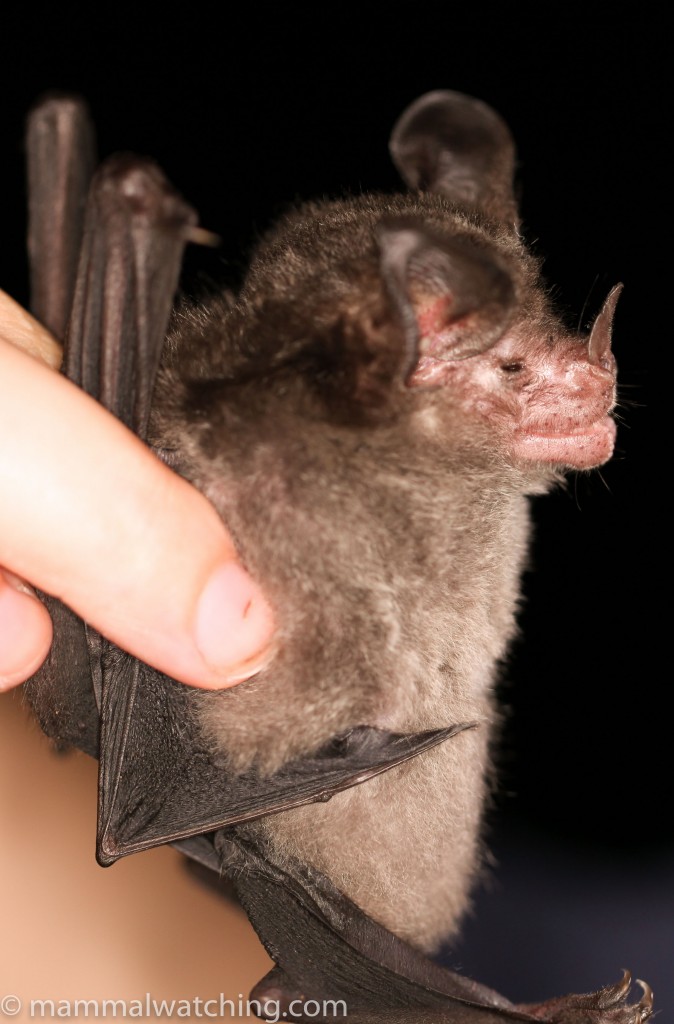
Northern Stripe-headed Round-eared Bat, Tonatia bakeri.
This Pygmy Fruit-eating Bat was also a lifer.
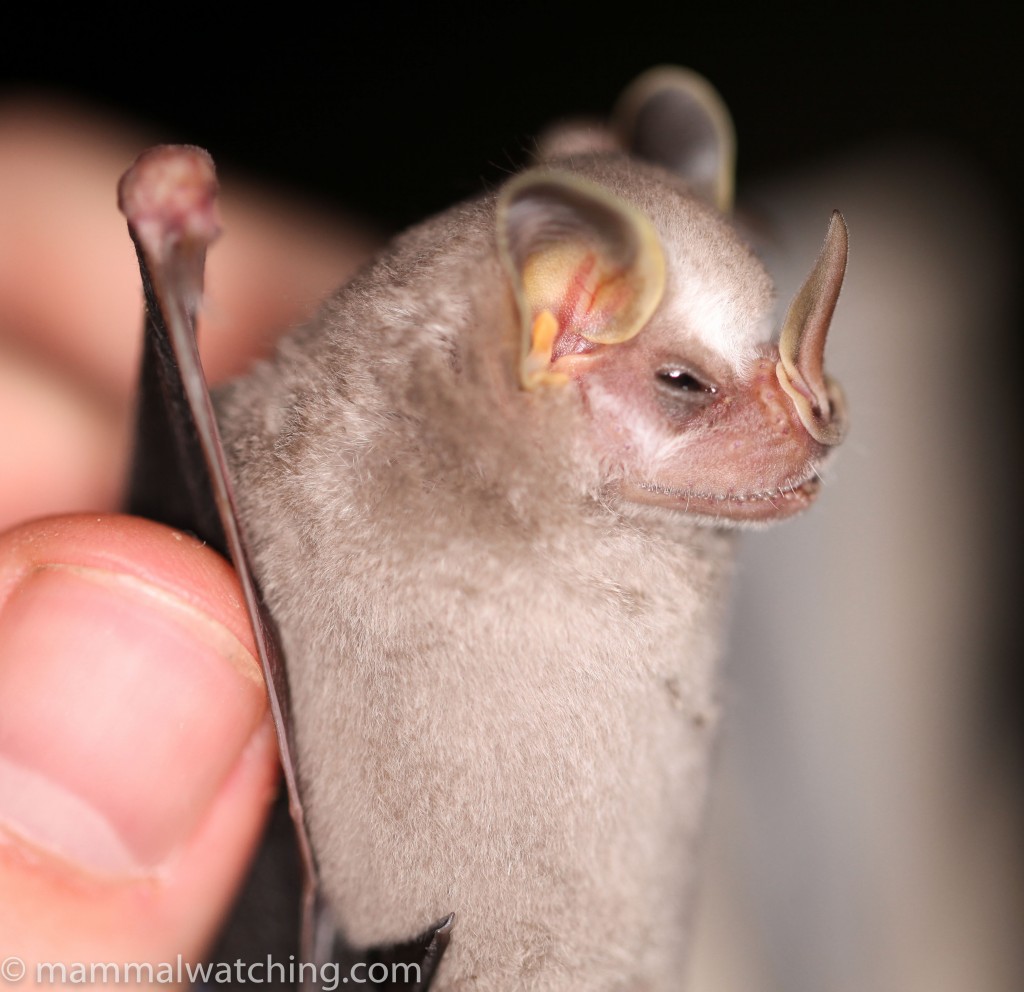
Pygmy Fruit-eating Bat, Artibeus phaeotis
While a Common Big-eared Bat was new for me in the hand.
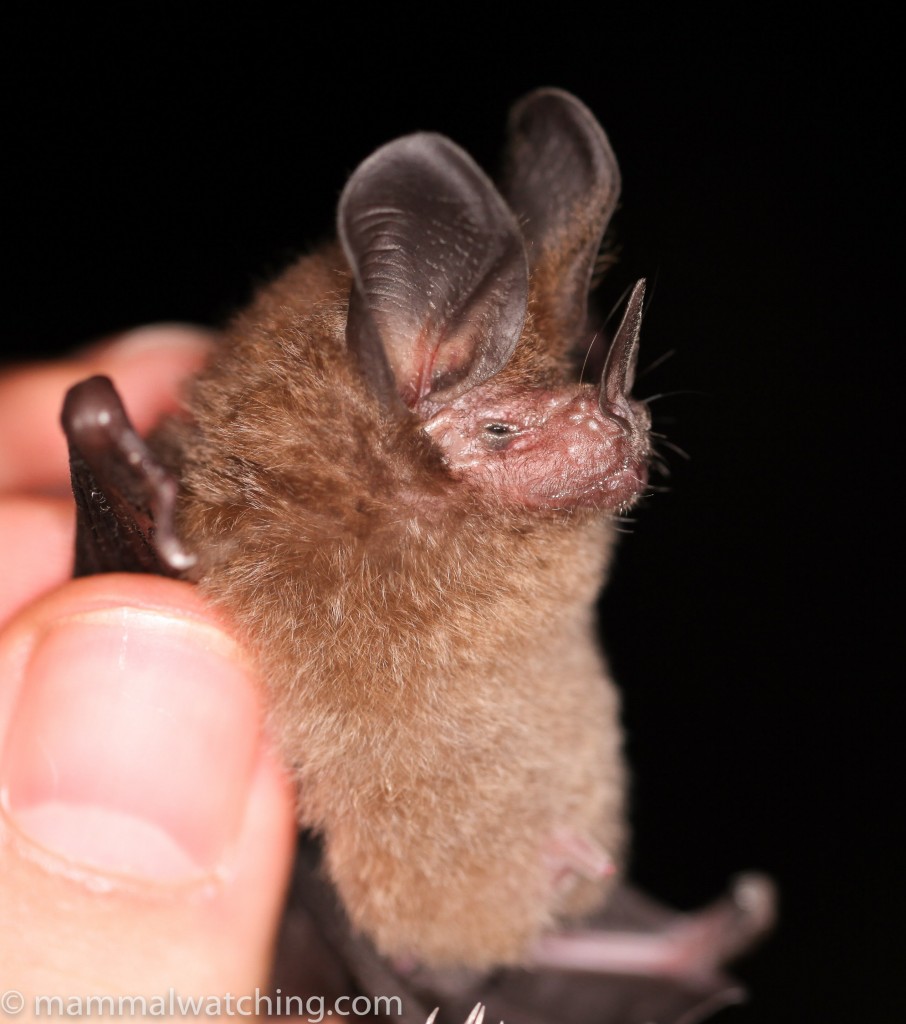
Common Big-eared Bat (Micronycteris microtis)
The only other mammals I saw on the island were Central-American Agoutis and Mantled Howlers around the accommodation, and Greater White-lined Bats roosting on the walls. Other mammals are around of course (see information here which still appears to be accurate). And the forest, I discovered, when I got home is full of chiggers. Evil little bastard chiggers. Pack repellent.
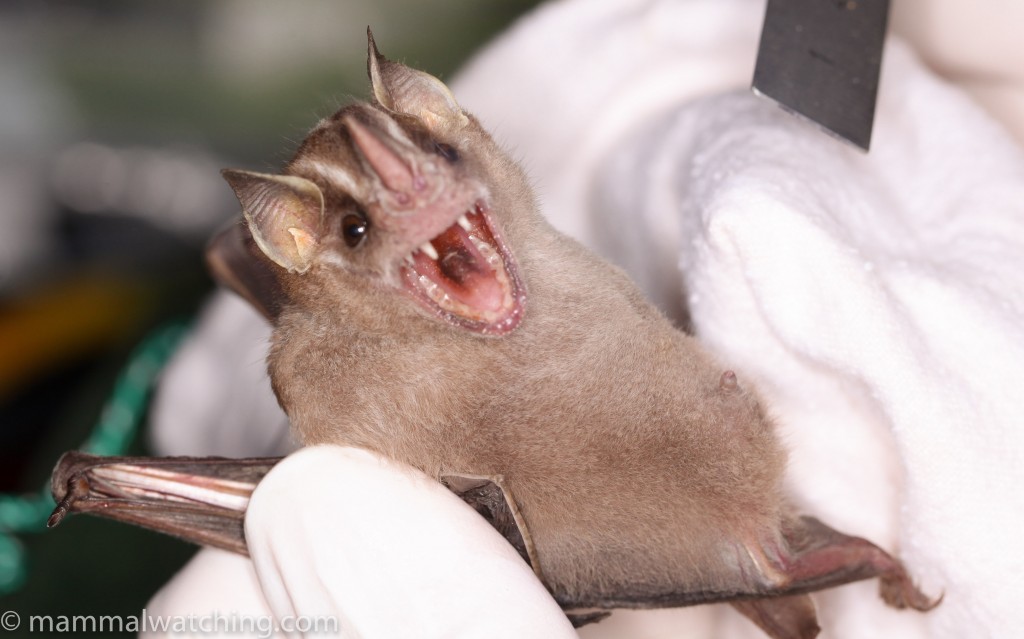
Heller’s Broad-nosed Bat (Platyrrhinus helleri)
Trip List
Seeing 33 species, including 12 lifers, in just four full days in Panama was well above my expectations, and I’m surprised that there aren’t more reports from Panama on this site. Hopefully that will change and I’d like to go back, perhaps to visit the Pipeline Road and Burbar Yar Lodge which sounds like a top spot, and where there’s a chance for Water Opossums among other things.
F Dark Four-eyed Opossum Philander melanurus
F Southern Opossum Didelphis marsupialis
F Central American Woolly Opossum Caluromys derbianus
Nine-banded Armadillo Dasypus novemcinctus
Hoffmann’s Two-toed Sloth Choloepus hoffmanni
Red-tailed Squirrel Sciurus granatensis
Central American Agouti Dasyprocta punctata
Paca Cuniculus paca
F Lesser Cabybara Hydrochoerus isthmius
F Tomes’ Spiny Rat Proechimys semispinosus
F Rufous Tree Rat Diplomys labilis
F Western Lowland Olingo Bassaricyon medius
Kinkajou Potos flavus
White-nosed Coati
Greater White-lined Bat Saccopteryx bilineata
Greater Fishing Bat Noctilio leporinus
Moustached Bat Pteronotus rubiginosus
F Common Big-eared Bat Micronycteris microtis
F Northern Stripe-headed Round-eared Bat Tonatia bakeri
F Spectral Bat Vampyrum spectrum
Merriam’s Long-tongued Bat Glossophaga mutica
F Orange Nectar Bat Lonchophylla robusta
Seba’s Short-tailed Bat Carollia perspicillata
Common Tent-making Bat Uroderma bilobatum
Heller’s Broad-nosed Bat Platyrrhinus helleri
Jamaican Fruit-eating Bat Artibeus jamaicensis
F Pygmy Fruit-eating Bat Artibeus phaeotis
Thomas’ Fruit-eating Bat Artibeus watsoni
Pallas’ Mastiff Bat Molossus molossus
Panamanian White-throated Capuchin
F Geoffroy’s Tamarin Saguinus geoffroyi
Mantled Howler Monkey Alouatta palliata
Collared Peccary (Javelina) Dicotyles tajacu
A big thanks to Fiona Reid, Cheryl Antonucci, Bill Adsett, Richard Webb and Rachel Page for their help before I got to Panama, and to Thomas Hiller (and his assistants), Jeff Higgott and the Canopy family guides, Eliecer and Alex, when I was there. I wouldn’t have seen half as much without them. Thanks also to everyone who responded to my RFI on the blog.
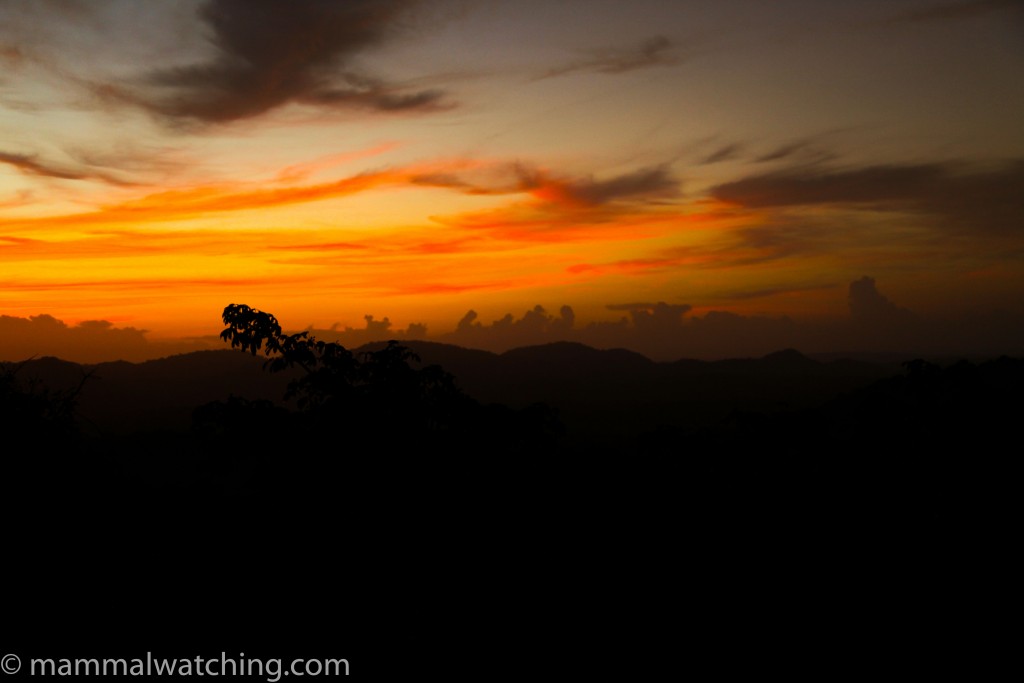
Canopy Tower sunset
1 Comment
Leave a Reply
You must be logged in to post a comment.


Leslie Z Sokolow
Terrific report. It takes me back decades to the early 80s when I was lucky enough to live on Barro Colorado Island for 10 months. Back then, tapirs were fed nasty buckets of wet oatmeal each afternoon thus commonly seen. I also saw Brocket deer regularly when I walked the trails at night.
I need to wrangle myself an invite to revisit there before I die.